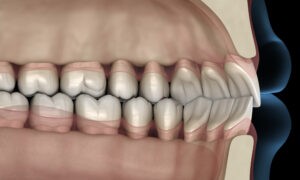
Occlusion should be considered across every area of dentistry. It is key in the planning of any dental treatment including orthodontic, cosmetic, and restorative options.
Malocclusion can significantly impact patients’ oral health. Caries and periodontitis might be more prevalent, and the risk of trauma may increase. Patients may also feel self-conscious about their smile, and seek treatment to improve their aesthetics.
Special care should always be taken when planning restorative treatment to assess occlusion. This will allow clinicians to provide patients with the best solutions.
Restoration design
When providing a dental bridge, for example, an accurate bite registration is required. This is because the supporting teeth will need to absorb any occlusal forces. In turn, the longevity of the restoration will be protected.
Special considerations must also be made when providing a dental implant supported prosthesis. Depending on its location, a prosthesis may be load-bearing. This should be avoided or minimised where possible. Sometimes, by recontouring the opposing tooth the load and occlusal contact can be reduced. In the long-term, the implant structure and prosthesis can be protected against excessive force.
We can expect any restoration to be exposed to a certain amount of force. This can depend on its location. Small forces are exerted when chewing, and might lead to fatigue failure over time. When occlusion is not taken into account, the restoration is likely to be subjected to excessive forces.
Traditional limitations
If a dental impression of a prepared tooth is not accurate, restoration failure is more likely. It could produce poor aesthetic and functional outcomes. It’s important that stress bearing areas are identified, and the pressure relieved. This is because restorations placed in these areas may become stress bearing zones.
Traditionally, bite articulating paper is used to record contact areas. This is useful for providing basic information about occlusion. However, it doesn’t take into account patients’ unique chewing patterns.
Current digital options
Intraoral scanners are fast becoming a popular digital impression solution. However, they cannot provide a sufficient bite registration. Some treatment planning software may allow clinicians to simulate the teeth meeting. But they will not accurately reproduce force and chewing cycles. This information is key in restorative dentistry, as it can impact long-term success.
Digital advancement
Many clinicians continue to use traditional methods to record occlusion and a bite registration. This is because the technology needed to reproduce a chewing cycle is not currently available. A digital system capable of replacing the traditional bite registration would revolutionise restorative dentistry. Future dental restorations would experience limited occlusal forces, resulting in a longer lifespan. This will enable patients to get the most out of the investment they’ve made in their oral health.

Stephen Claffey Managing Director of Dental Pathway™ and the Independent Dental Advisory Board™